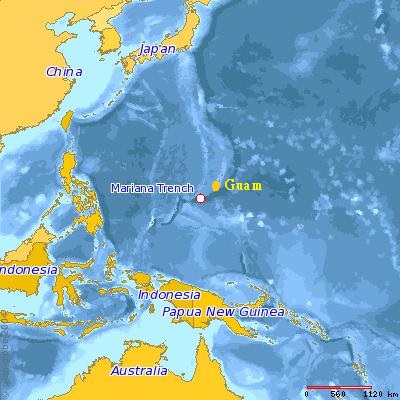|
HAWAII MR1
The HAWAII MR1 is a seafloor imaging system developed by the Hawaii Mapping Research Group (HMRG) in 1991. HAWAII MR1 is short for HIGP (Hawaii Institute of Geophysics and Planetology) Acoustic Wide Angle Imaging Instrument, Mapping Researcher 1. This system is the first to use all-digital signal processing. See section titled HAWAII MR1/MR2. It has been used in the discovery of several objects and locations of note, examples being the USS ''Yorktown'' and the HMRG Deep. Description The MR1 system is relatively small and stable, and is towed at a depth of 80 to 100 meters. Because it is not hull-mounted, this data collection system has the ability to withstand rough conditions. The HAWAII MR1 also has the capability to measure and collect bathymetric and backscatter data simultaneously, and record raw acoustic data independently of human supervision. After collecting data, the data can be processed with software available from HMRG. The width of a scan produced by the system v ... [...More Info...] [...Related Items...] OR: [Wikipedia] [Google] [Baidu] |
USS Yorktown (CV-5)
USS ''Yorktown'' (CV-5) was an aircraft carrier that served in the United States Navy during World War II. Named after the Battle of Yorktown in 1781, she was commissioned in 1937. ''Yorktown'' was the lead ship of the , which was designed on the basis of lessons learned from operations with the converted battlecruisers of the and the smaller purpose-built . ''Yorktown'' was at port in Norfolk during the attack on Pearl Harbor, having just completed a patrol of the Atlantic Ocean. She then sailed to San Diego in late December 1941 and was incorporated as the flagship of Task Force 17. Together with the carrier , she successfully attacked Japanese shipping off the east coast of New Guinea in early March 1942. Her aircraft sank or damaged several warships supporting the invasion of Tulagi in early May. ''Yorktown'' rendezvoused with ''Lexington'' in the Coral Sea and attempted to stop the invasion of Port Moresby, Papua New Guinea. They sank the light aircraft carrier on 7 May ... [...More Info...] [...Related Items...] OR: [Wikipedia] [Google] [Baidu] |
HMRG Deep
The Sirena Deep, originally named the HMRG Deep, was discovered in 1997 by a team of scientists from Hawaii. Its directly measured depth of is third only to the Challenger Deep and Horizon Deep, currently the deepest known directly measured places in the ocean. It lies along the Mariana Trench, 200 kilometers to the east of the Challenger Deep and 145 km south of Guam. Formation The Sirena Deep was most probably formed, not through transform fault motion as previously thought, but through a north-south convergence of the Caroline plate and the Pacific plate, in which the Caroline plate is subducting. A group of scientists have hypothesized that the great depth of the Mariana Trench, the Challenger Deep, and the Sirena Deep is due to a tear in the subducting Caroline plate, causing deformation of the Pacific plate above. This tear would be located to the south of Guam, the same location of the deepest portion of the Mariana Trench. The tear would lead to unusual regiona ... [...More Info...] [...Related Items...] OR: [Wikipedia] [Google] [Baidu] |
Bathymetric
Bathymetry (; ) is the study of underwater depth of ocean floors (''seabed topography''), lake floors, or river floors. In other words, bathymetry is the underwater equivalent to hypsometry or topography. The first recorded evidence of water depth measurements are from Ancient Egypt over 3000 years ago. Bathymetric (or hydrographic) charts are typically produced to support safety of surface or sub-surface navigation, and usually show seafloor relief or terrain as contour lines (called depth contours or isobaths) and selected depths ('' soundings''), and typically also provide surface navigational information. Bathymetric maps (a more general term where navigational safety is not a concern) may also use a Digital Terrain Model and artificial illumination techniques to illustrate the depths being portrayed. The global bathymetry is sometimes combined with topography data to yield a global relief model. Paleobathymetry is the study of past underwater depths. Seabed topography ... [...More Info...] [...Related Items...] OR: [Wikipedia] [Google] [Baidu] |
Backscatter
In physics, backscatter (or backscattering) is the reflection of waves, particles, or signals back to the direction from which they came. It is usually a diffuse reflection due to scattering, as opposed to specular reflection as from a mirror, although specular backscattering can occur at normal incidence with a surface. Backscattering has important applications in astronomy, photography, and medical ultrasonography. The opposite effect is forward scatter, e.g. when a translucent material like a cloud diffuses sunlight, giving soft light. Backscatter of waves in physical space Backscattering can occur in quite different physical situations, where the incoming waves or particles are deflected from their original direction by different mechanisms: *Diffuse reflection from large particles and Mie scattering, causing alpenglow and gegenschein, and showing up in weather radar; * Inelastic collisions between electromagnetic waves and the transmitting medium (Brillouin scattering and ... [...More Info...] [...Related Items...] OR: [Wikipedia] [Google] [Baidu] |
Robert Ballard
Robert Duane Ballard (born June 30, 1942) is an American retired Navy officer and a professor of oceanography at the University of Rhode Island who is most noted for his work in underwater archaeology: maritime archaeology and archaeology of shipwrecks. He is best known for the discoveries of the wrecks of the RMS ''Titanic'' in 1985, the battleship ''Bismarck'' in 1989, and the aircraft carrier in 1998. He discovered the wreck of John F. Kennedy's ''PT-109'' in 2002 and visited Biuku Gasa and Eroni Kumana, who saved its crew. Despite his long successes in shipwrecks, Ballard considers his most important discovery to be that of hydrothermal vents. Ballard has also established the JASON Project and leads ocean exploration on the research vessel E/V ''Nautilus''. . Downloahere Early life Robert Ballard grew up in Pacific Beach, San Diego, California to a mother of German heritage and a father of British heritage. He has attributed his early interest in underwater expl ... [...More Info...] [...Related Items...] OR: [Wikipedia] [Google] [Baidu] |
RMS Titanic
RMS ''Titanic'' was a British passenger liner, operated by the White Star Line, which sank in the North Atlantic Ocean on 15 April 1912 after striking an iceberg during her maiden voyage from Southampton, England, to New York City, United States. Of the estimated 2,224 passengers and crew aboard, more than 1,500 died, making it the deadliest sinking of a single ship up to that time. It remains the deadliest peacetime sinking of a superliner or cruise ship. The disaster drew public attention, provided foundational material for the disaster film genre, and has inspired many artistic works. RMS ''Titanic'' was the largest ship afloat at the time she entered service and the second of three s operated by the White Star Line. She was built by the Harland and Wolff shipyard in Belfast. Thomas Andrews, the chief naval architect of the shipyard, died in the disaster. ''Titanic'' was under the command of Captain Edward Smith, who went down with the ship. The ocean liner carri ... [...More Info...] [...Related Items...] OR: [Wikipedia] [Google] [Baidu] |
Challenger Deep
The Challenger Deep is the deepest-known point of the seabed of Earth, with a depth of by direct measurement from deep-diving submersibles, remotely operated underwater vehicles and benthic landers, and (sometimes) slightly more by sonar bathymetry. The Challenger Deep is located in the western Pacific Ocean, at the southern end of the Mariana Trench, near the Mariana Islands. According to the August 2011 version of the GEBCO Gazetteer of Undersea Feature Names, the Challenger Deep is deep at . This location is in the ocean territory of the Federated States of Micronesia. The depression is named after the British Royal Navy survey ship , whose expedition of 1872–1876 made the first recordings of its depth. The high water pressure at this depth makes designing and operating exploratory craft difficult. The first descent by any vehicle was by Jacques Piccard and Don Walsh in the manned bathyscaphe ''Trieste'' in January 1960; unmanned visits followed in 1996, 1998 and 2009. ... [...More Info...] [...Related Items...] OR: [Wikipedia] [Google] [Baidu] |




